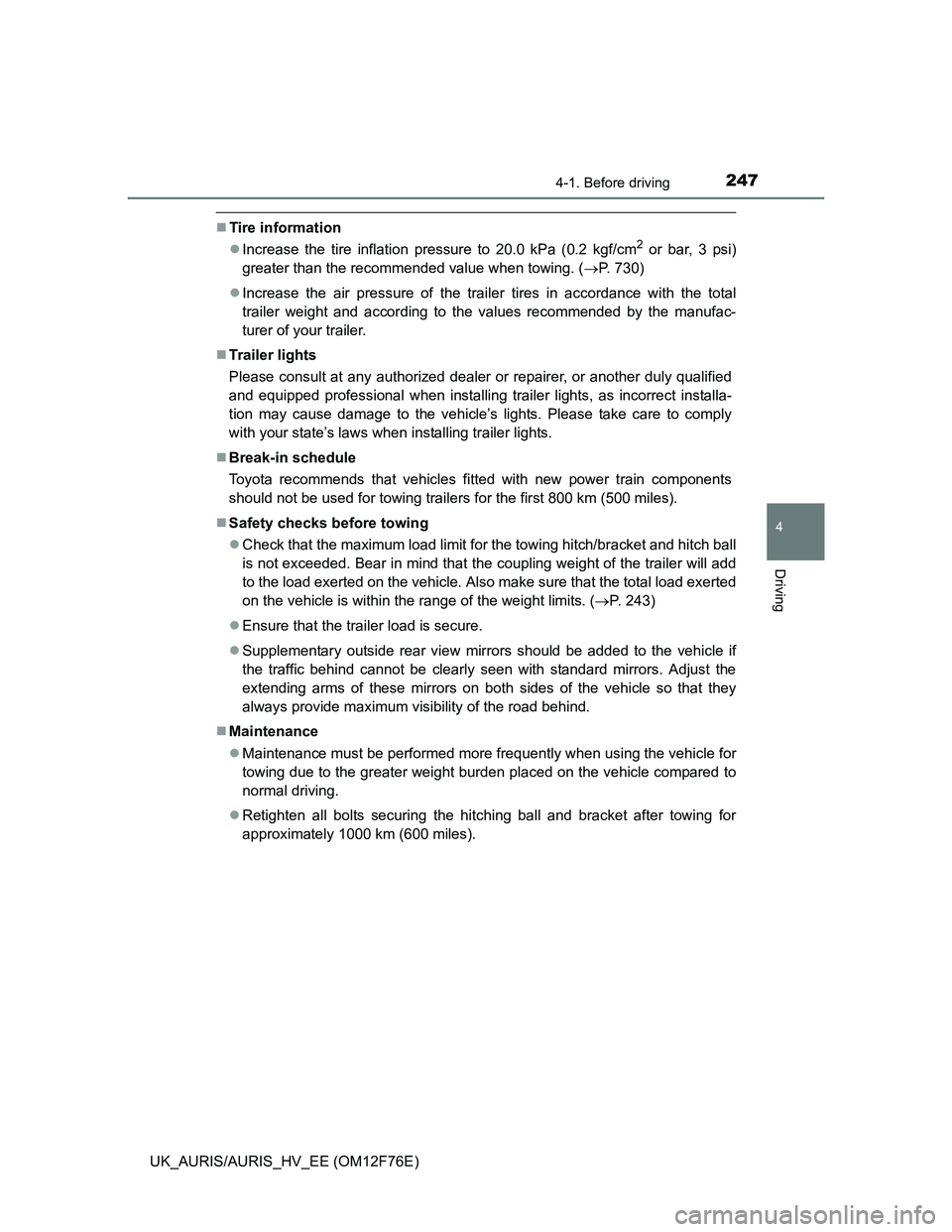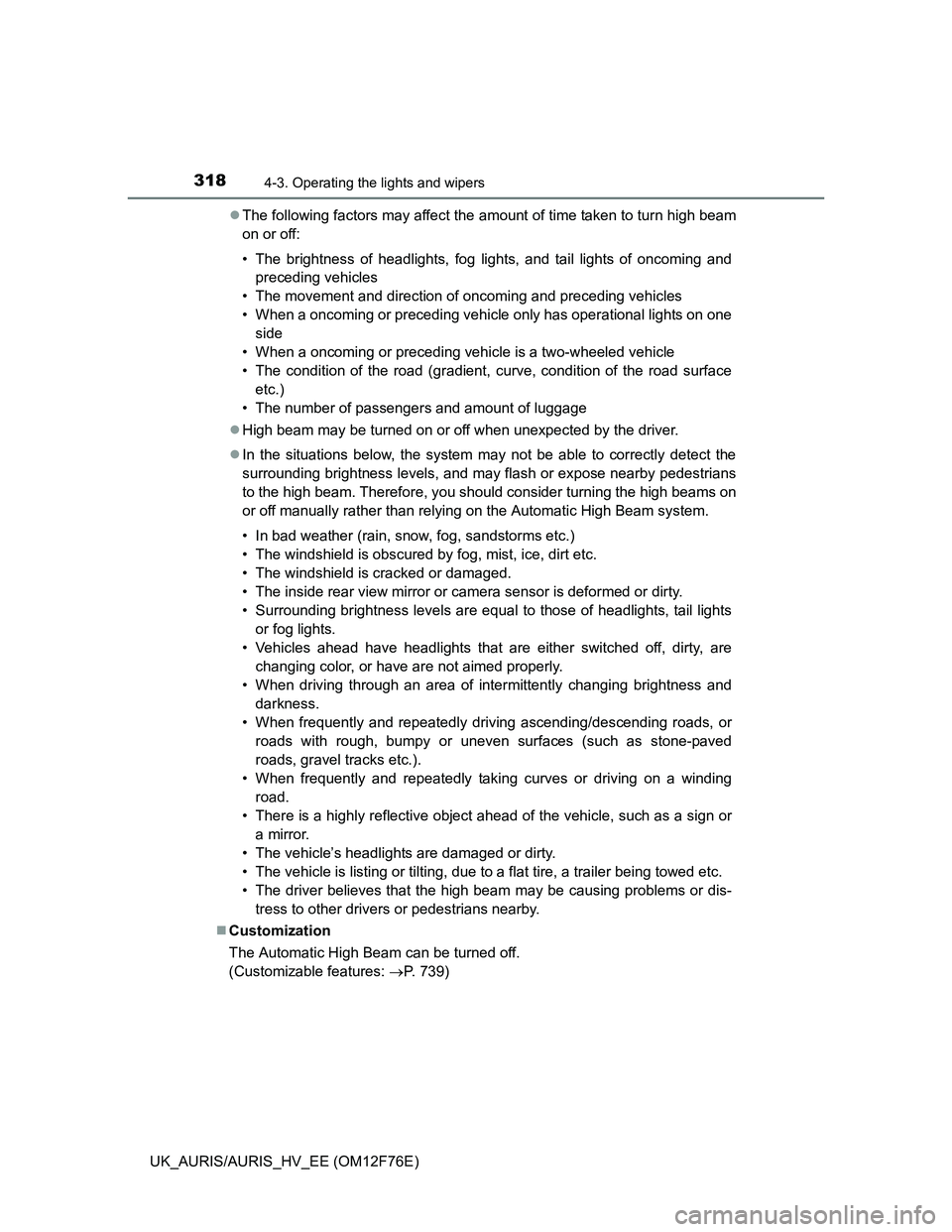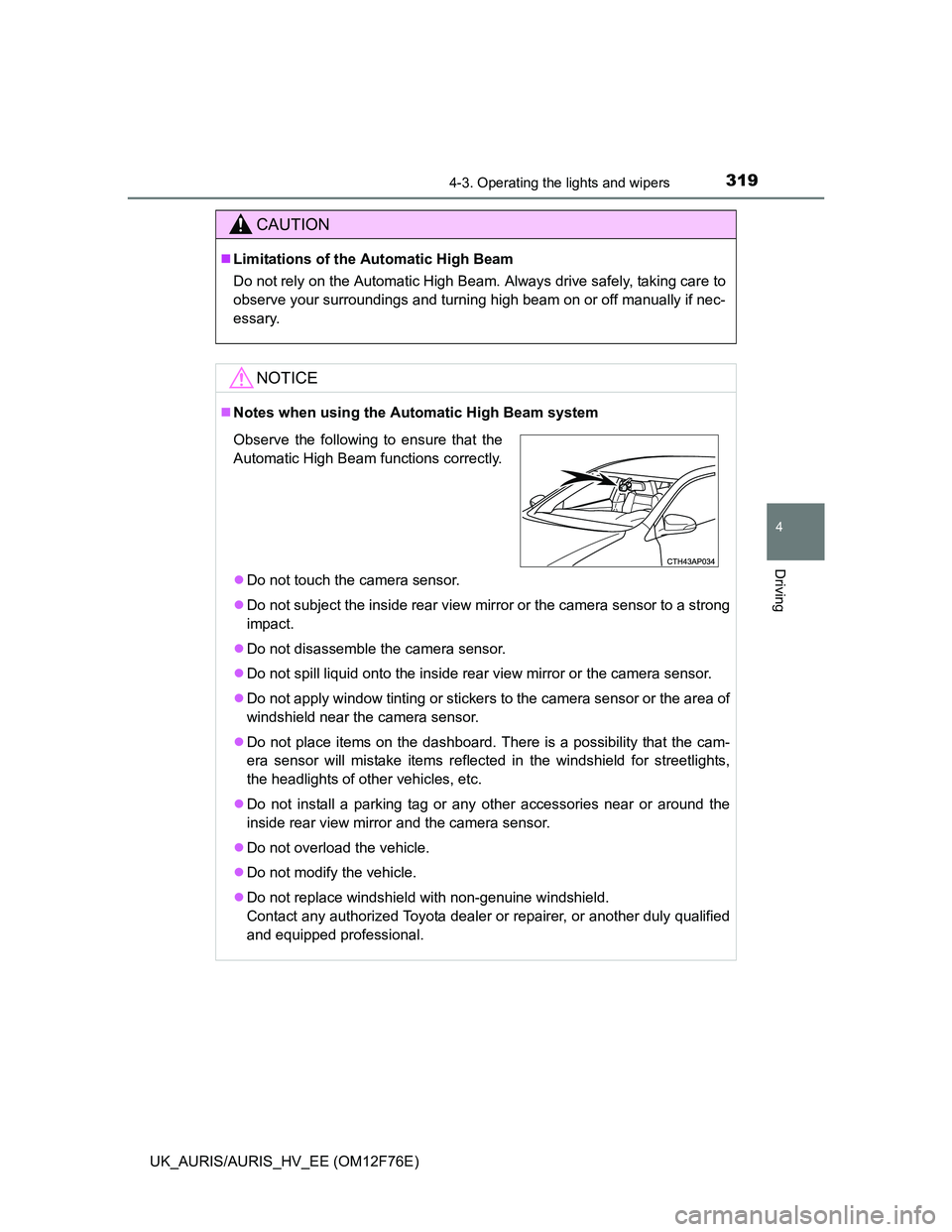2013 TOYOTA AURIS HYBRID mirror
[x] Cancel search: mirrorPage 232 of 768

2324-1. Before driving
UK_AURIS/AURIS_HV_EE (OM12F76E)
CAUTION
Observe the following precautions.
Failure to do so may result in death or serious injury.
When driving the vehicle
Except hybrid model: During normal driving, do not turn off the engine.
Turning the engine off while driving will not cause loss of steering or brak-
ing control, but the power assist to these systems will be lost. This will
make it more difficult to steer and brake, so you should pull over and stop
the vehicle as soon as it is safe to do so.
However, in the event of an emergency, such as if it becomes impossible
to stop the vehicle in the normal way: P. 585
Hybrid model: During normal driving, do not turn off the hybrid system.
Turning the hybrid system off while driving will not cause loss of steering
or braking control, but the power assist to these systems will be lost. This
will make it more difficult to steer and brake, so you should pull over and
stop the vehicle as soon as it is safe to do so.
However, in the event of an emergency, such as if it becomes impossible
to stop the vehicle in the normal way: P. 585
Use engine braking (downshift [except hybrid model] or shift position B
[hybrid model]) to maintain a safe speed when driving down a steep hill.
Using the brakes continuously may cause the brakes to overheat and lose
effectiveness. (P. 284, 289, 294, 297)
Do not adjust the positions of the steering wheel, the seat, or the inside or
outside rear view mirrors while driving.
Doing so may result in a loss of vehicle control.
Always check that all passengers’ arms, heads or other parts of their body
are not outside the vehicle.
Page 247 of 768

2474-1. Before driving
UK_AURIS/AURIS_HV_EE (OM12F76E)
4
Driving
Tire information
Increase the tire inflation pressure to 20.0 kPa (0.2 kgf/cm
2 or bar, 3 psi)
greater than the recommended value when towing. (P. 730)
Increase the air pressure of the trailer tires in accordance with the total
trailer weight and according to the values recommended by the manufac-
turer of your trailer.
Trailer lights
Please consult at any authorized dealer or repairer, or another duly qualified
and equipped professional when installing trailer lights, as incorrect installa-
tion may cause damage to the vehicle’s lights. Please take care to comply
with your state’s laws when installing trailer lights.
Break-in schedule
Toyota recommends that vehicles fitted with new power train components
should not be used for towing trailers for the first 800 km (500 miles).
Safety checks before towing
Check that the maximum load limit for the towing hitch/bracket and hitch ball
is not exceeded. Bear in mind that the coupling weight of the trailer will add
to the load exerted on the vehicle. Also make sure that the total load exerted
on the vehicle is within the range of the weight limits. (P. 243)
Ensure that the trailer load is secure.
Supplementary outside rear view mirrors should be added to the vehicle if
the traffic behind cannot be clearly seen with standard mirrors. Adjust the
extending arms of these mirrors on both sides of the vehicle so that they
always provide maximum visibility of the road behind.
Maintenance
Maintenance must be performed more frequently when using the vehicle for
towing due to the greater weight burden placed on the vehicle compared to
normal driving.
Retighten all bolts securing the hitching ball and bracket after towing for
approximately 1000 km (600 miles).
Page 258 of 768

2584-1. Before driving
UK_AURIS/AURIS_HV_EE (OM12F76E)
Tire information
Increase the tire inflation pressure to 20.0 kPa (0.2 kgf/cm
2 or bar, 3 psi)
greater than the recommended value when towing. (P. 730)
Increase the air pressure of the trailer tires in accordance with the total
trailer weight and according to the values recommended by the manufac-
turer of your trailer.
Trailer lights
Please consult at any authorized dealer or repairer, or another duly qualified
and equipped professional when installing trailer lights, as incorrect installa-
tion may cause damage to the vehicle’s lights. Please take care to comply
with your state’s laws when installing trailer lights.
Break-in schedule
Toyota recommends that vehicles fitted with new power train components
should not be used for towing trailers for the first 800 km (500 miles).
Safety checks before towing
Check that the maximum load limit for the towing hitch/bracket and hitch ball
is not exceeded. Bear in mind that the coupling weight of the trailer will add
to the load exerted on the vehicle. Also make sure that the total load exerted
on the vehicle is within the range of the weight limits. (P. 243)
Ensure that the trailer load is secure.
Supplementary outside rear view mirrors should be added to the vehicle if
the traffic behind cannot be clearly seen with standard mirrors. Adjust the
extending arms of these mirrors on both sides of the vehicle so that they
always provide maximum visibility of the road behind.
Maintenance
Maintenance must be performed more frequently when using the vehicle for
towing due to the greater weight burden placed on the vehicle compared to
normal driving.
Retighten all bolts securing the hitching ball and bracket after towing for
approximately 1000 km (600 miles).
Page 318 of 768

3184-3. Operating the lights and wipers
UK_AURIS/AURIS_HV_EE (OM12F76E)The following factors may affect the amount of time taken to turn high beam
on or off:
• The brightness of headlights, fog lights, and tail lights of oncoming and
preceding vehicles
• The movement and direction of oncoming and preceding vehicles
• When a oncoming or preceding vehicle only has operational lights on one
side
• When a oncoming or preceding vehicle is a two-wheeled vehicle
• The condition of the road (gradient, curve, condition of the road surface
etc.)
• The number of passengers and amount of luggage
High beam may be turned on or off when unexpected by the driver.
In the situations below, the system may not be able to correctly detect the
surrounding brightness levels, and may flash or expose nearby pedestrians
to the high beam. Therefore, you should consider turning the high beams on
or off manually rather than relying on the Automatic High Beam system.
• In bad weather (rain, snow, fog, sandstorms etc.)
• The windshield is obscured by fog, mist, ice, dirt etc.
• The windshield is cracked or damaged.
• The inside rear view mirror or camera sensor is deformed or dirty.
• Surrounding brightness levels are equal to those of headlights, tail lights
or fog lights.
• Vehicles ahead have headlights that are either switched off, dirty, are
changing color, or have are not aimed properly.
• When driving through an area of intermittently changing brightness and
darkness.
• When frequently and repeatedly driving ascending/descending roads, or
roads with rough, bumpy or uneven surfaces (such as stone-paved
roads, gravel tracks etc.).
• When frequently and repeatedly taking curves or driving on a winding
road.
• There is a highly reflective object ahead of the vehicle, such as a sign or
a mirror.
• The vehicle’s headlights are damaged or dirty.
• The vehicle is listing or tilting, due to a flat tire, a trailer being towed etc.
• The driver believes that the high beam may be causing problems or dis-
tress to other drivers or pedestrians nearby.
Customization
The Automatic High Beam can be turned off.
(Customizable features: P. 739)
Page 319 of 768

3194-3. Operating the lights and wipers
UK_AURIS/AURIS_HV_EE (OM12F76E)
4
Driving
CAUTION
Limitations of the Automatic High Beam
Do not rely on the Automatic High Beam. Always drive safely, taking care to
observe your surroundings and turning high beam on or off manually if nec-
essary.
NOTICE
Notes when using the Automatic High Beam system
Do not touch the camera sensor.
Do not subject the inside rear view mirror or the camera sensor to a strong
impact.
Do not disassemble the camera sensor.
Do not spill liquid onto the inside rear view mirror or the camera sensor.
Do not apply window tinting or stickers to the camera sensor or the area of
windshield near the camera sensor.
Do not place items on the dashboard. There is a possibility that the cam-
era sensor will mistake items reflected in the windshield for streetlights,
the headlights of other vehicles, etc.
Do not install a parking tag or any other accessories near or around the
inside rear view mirror and the camera sensor.
Do not overload the vehicle.
Do not modify the vehicle.
Do not replace windshield with non-genuine windshield.
Contact any authorized Toyota dealer or repairer, or another duly qualified
and equipped professional.
Observe the following to ensure that the
Automatic High Beam functions correctly.
Page 385 of 768

385
5Interior features
UK_AURIS/AURIS_HV_EE (OM12F76E)5-1. Using the air conditioning
system and defogger
Heater system ................... 386
Automatic air conditioning
system (without dual
operation) ........................ 391
Automatic air conditioning
system (with dual
operation) ........................ 400
Power heater ..................... 408
Rear window and
outside rear view
mirror defoggers .............. 410
5-2. Using the audio system
Audio system types ........... 412
Using the radio .................. 416
Using the CD player .......... 420
Playing back MP3 and
WMA discs....................... 425
Operating an iPod.............. 431
Operating a USB
memory............................ 440
Optimal use of the audio
system ............................. 447
Using the AUX port ............ 449
Using the steering wheel
audio switches ................. 4505-3. Using the interior lights
Interior lights list ................. 453
• Interior lights .................. 454
• Vanity lights ................... 454
• Personal lights ............... 455
5-4. Using the storage features
List of storage features ...... 457
• Glove box ...................... 458
• Console box .................. 458
• Bottle holders ................ 459
• Cup holders ................... 460
• Auxiliary boxes .............. 461
Luggage compartment
features............................ 463
5-5. Other interior features
Sun visors and vanity
mirrors ............................. 470
Clock .................................. 471
Outside temperature
display ............................. 472
Portable ashtray................. 474
Power outlets ..................... 475
Seat heaters ...................... 477
Armrest .............................. 480
Coat hooks......................... 481
Assist grips ........................ 482
Panoramic roof shade........ 483
Page 410 of 768

4105-1. Using the air conditioning system and defogger
UK_AURIS/AURIS_HV_EE (OM12F76E)
Turns the defoggers on/off
Except hybrid model
The defoggers will automatically
turn off the operation time. The
operation time is between 15 min-
utes and 1 hour depending on the
ambient temperature and vehicle
speed.
Hybrid model
The defoggers will automatically
turn off after approximately 15 min-
utes.
Rear window and outside rear view mirror
defoggers
Defoggers are used to defog the rear window, and to remove
raindrops, dew and frost from the outside rear view mirrors.
Page 411 of 768

4115-1. Using the air conditioning system and defogger
UK_AURIS/AURIS_HV_EE (OM12F76E)
5
Interior features
The defoggers can be operated when
Vehicles without a smart entry & start system (except hybrid model)
The engine switch is in the “ON” position.
Vehicles with a smart entry & start system (except hybrid model)
The engine switch is in IGNITION ON mode.
Hybrid model
The power switch is in ON mode.
Outside rear view mirror defoggers
Turning the rear window defogger on will turn the outside rear view mirror
defoggers on.
CAUTION
When the outside rear view mirror defoggers are on
Do not touch the outside surface of the rear view mirrors, as they can
become very hot and burn you.